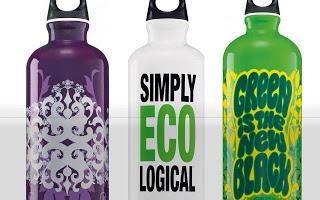 Drinking water should be a gloriously guilt-free activity. H2O won't make you fat, give you cancer or stain your teeth a revolting shade of yellow. It's second only to soft drinks as the Australian beverage of choice, ever since marketers thought to package it for us in handy plastic bottles. But now the green lobby informs us we may as well be cubbing baby seals with our Plastic water bottles, so great is the environmental havoc wreaked by their manufacture and disposal. Some resourceful consumers have taken to reusing the containers multiple times; others have switched to Reusable water bottles.
Drinking water should be a gloriously guilt-free activity. H2O won't make you fat, give you cancer or stain your teeth a revolting shade of yellow. It's second only to soft drinks as the Australian beverage of choice, ever since marketers thought to package it for us in handy plastic bottles. But now the green lobby informs us we may as well be cubbing baby seals with our Plastic water bottles, so great is the environmental havoc wreaked by their manufacture and disposal. Some resourceful consumers have taken to reusing the containers multiple times; others have switched to Reusable water bottles.While we fuss over the impact of water containers on the environment, however, most of us have overlooked their potential impact on our health. Many water bottles on the market, like many soft drink containers, are made of a hard plastic called polyethylene terephthalate, or PET. While the material is perfectly safe for single use, it's not designed for repeated reuse, says Kellogg Schwab, an environmental microbiologistat Johns Hopkins Bloomberg School of Public Health: "Your mouth leaves a film that harbors bacteria, and the bottle's narrow mouth makes it hard to clean."
Reusable water bottles merit scrutiny as well. Like many rock climbers, Scott Belcher used to carry a Nalgene water bottle made of polycarbonate, a sturdy, clear plastic. As an associate pharmacology professor at the University of Cincinnati, he knew that polycarbonates contain bisphenol A (BPA), a synthetic hormone that mimics estrogen. What he didn't know was if or how much BPA wound up in his water. In experiments, he learned that trace amounts of BPA do seep into room-temperature water. But he was startled to find that when the containers were filled with boiling water--a common practice for climbers in cold climates--the BPA released 55 times as fast. His research, published in January in the journal Toxicology Letters, spurred alarm among not just water drinkers but also parents: 95% of baby bottles, which are routinely filled with hot water to make formula, are made of polycarbonates.
Is Your Water Bottle Safe? Here's what you need to know before you chug that H2O. Single-Use PET Polycarbonate HDPE is a lightweight plastic used in many drink bottles. This thermoplastic polymer is used in many products, including water containers. Studies show polycarbonates can leach a potentially harmful synthetic hormone into your drink. Scientists and health advocates have reported no known problems with Stainless steel container. It doesn't leach or react. It is Recyclable. Stainless steel rates up there with glass as a safe, reliable material. Drink up!
